Ecology and phytosociology of the tropical dry deciduous forests of Kawal Wildlife Sanctuary, Telangana, India
E. Narasimha Murthy
Department of Botany, Satavahana University, Karimnagar, Telangana 505001, India
murthyensnbc@gmail.com, murthyen@yahoo.co.in
doi: http://dx.doi.org/10.11609/JoTT.o3884.6972-9
Editor: B. Ravi Prasad Rao, Sri Krishnadevaraya University, Anantapur, India. Date of publication: 26 March 2015 (online & print)
Manuscript details: Ms # o3884 | Received 18 December 2013 | Final received 12 February 2015 | Finally accepted 28 February 2015
Citation: Murthy, E.N. (2015). Ecology and phytosociology of the tropical dry deciduous forests of Kawal Wildlife Sanctuary, Telangana, India. Journal of Threatened Taxa 7(3): 6972–6979; http://dx.doi.org/10.11609/JoTT.o3884.6972-9
Copyright: © Murthy 2015. Creative Commons Attribution 4.0 International License. JoTT allows unrestricted use of this article in any medium, reproduction and distribution by providing adequate credit to the authors and the source of publication.
Funding: CSIR- Counsel for Scientific and Industrial Research, New Delhi and National Remote Sensing Centre, ISRO, Hyderabad.
Competing Interest: The author declares no competing interests.
Author Details: E. Narasimha Murthy is working in Department of Botany, Satavahana University, Telangana. He is the recipient of senior research fellowship (CSIR-New Delhi), UGC- Dr. Kothari Post Doctoral Fellowship and APCOST Young Scientist Fellowship, working on Angiosperm taxonomy, forest ecology, ethno-botany and conservation biology.
Acknowledgements: The author thanks the Department of Space and the Director, NRSA, Hyderabad for partial financial assistance through the Eastern Ghats Biodiversity Characterization Project. I am thankful to Council for Scientific and Industrial Research (CSIR), New Delhi for funding in the form of Senior Research Fellow. I am owed to Prof. V.S. Raju, Department of Botany, Kakatiya University for his guidance to carryout this work. My thanks are due to Dr. C.S. Reddy, National Remote Sensing Centre, Hyderabad for his valuable technical support to fulfill this study. I thank the personnel and authorities of Andhra Pradesh Forest Department and G. Ravinder, Forest Ranger, Jannaram Forest Division for help during field work into Kawal Wildlife Sanctuary.
Abstract: The paper describes the species composition, abundance, density and community structure of the tropical dry deciduous forests of Kawal Wildlife Sanctuary. Phytosociological analysis was based on the data generated from the 81 sample plots laid at random covering the entire sanctuary area. A total of 177 Angiosperms of species were enumerated from the sampled quadrats. The species present as per preponderance are herbs 71, trees 55, climbers 33, and shrubs 18. The species diversity indices indicate the following facts: Shannon-Weiner index as 4.15, Simpson index value as 0.91, Margalef’s species richness index as 5.20, density of trees above 10 cm GBH class as 470 individuals per hectare. The total basal area of the tree species was 17.7m² ha-1. These statistics along with the composition of the forest, and information on the diversity of the communities as a whole provided a better insight into the state of the forests in the Kawal Wildlife Sanctuary.
Keywords: India, Kawal Wildlife Sanctuary, phytosociology, quantitative analysis, tropical dry deciduous forests.

INTRODUCTION
Species diversity in the tropics varies dramatically between habitats. Compared to the other tropical forest types, dry deciduous forests are amongst the most exploited and endangered ecosystems of the biosphere (Murphy & Lugo 1986; Janzen 1988; Gentry 1990; Bahuguna 1999). Information on floral composition, diversity and biomass are absolutely essential in understanding the forest ecosystem dynamics and conservation. Such studies may become a vital tool in the estimation of the level of adaptation to the environment and their ecological significance (Pascal & Pelissier 1996). Phytosociological data for the state of Andhra Pradesh in general and Telangana region in particular are scanty. Some of the earlier studies in this area are by Gopalkrishna (2000) for Warangal and for the southern Eastern Ghats by Reddy et al. (2008). Besides, no assessment of forest vegetation in terms of quantitative and floristic analysis has been done in the protected areas of the Deccan biogeographic region. The available local floral data collection endeavors have documented plant species occurring in the district based on random sampling surveys. Therefore, the present study is aimed at quantitative assessment of the vegetation of Kawal Wildlife Sanctuary.
Study Area
Kawal Wildlife Sanctuary (KWS), situated in Adilabad District is located 260km from Hyderabad, the state capital of Telangana, India. It lies between 19005’–19020’N and 78032’–79012’E, spread in an area of 892.23km2 (Fig. 1). It is one of the oldest sanctuaries in the state declared during 1965. It is a perfect tiger habitat with dense bamboo undergrowth and adequate prey population. It harbours endangered fauna like Indian Gaur, Four-horned Antelope and Grey Junglefowl. It is known for herds of Spotted Deer, Sambar, Black Buck, Nilgai and Gaur which are important tiger-prey. The vegetation in the sanctuary is a classic example of southern tropical dry deciduous forests (Champion & Seth 1968) with predominantly Tectona grandis and its associates like Anogeissus latifolia, Bombax ceiba, Boswellia serrata, Chloroxylon swietenia, Cleistanthus collinus, Diospyros melanoxylon, Haldinia cordifolia, Hardwickia binata, Mitragyna parviflora, Lannea coromandelica, Strychnos nux-vomica, Terminalia alata, Terminalia arjuna, etc. It protects the catchment of numerous perennial streams that ultimately drain into the river Godavari. KWS is becoming important in view of the government’s decision to recommend KWS as a tiger reserve. It has enormous potential for research in conservation of biodiversity. Hence, the present study was undertaken to describe the structure and floristic composition of the vegetation occupying the KWS.
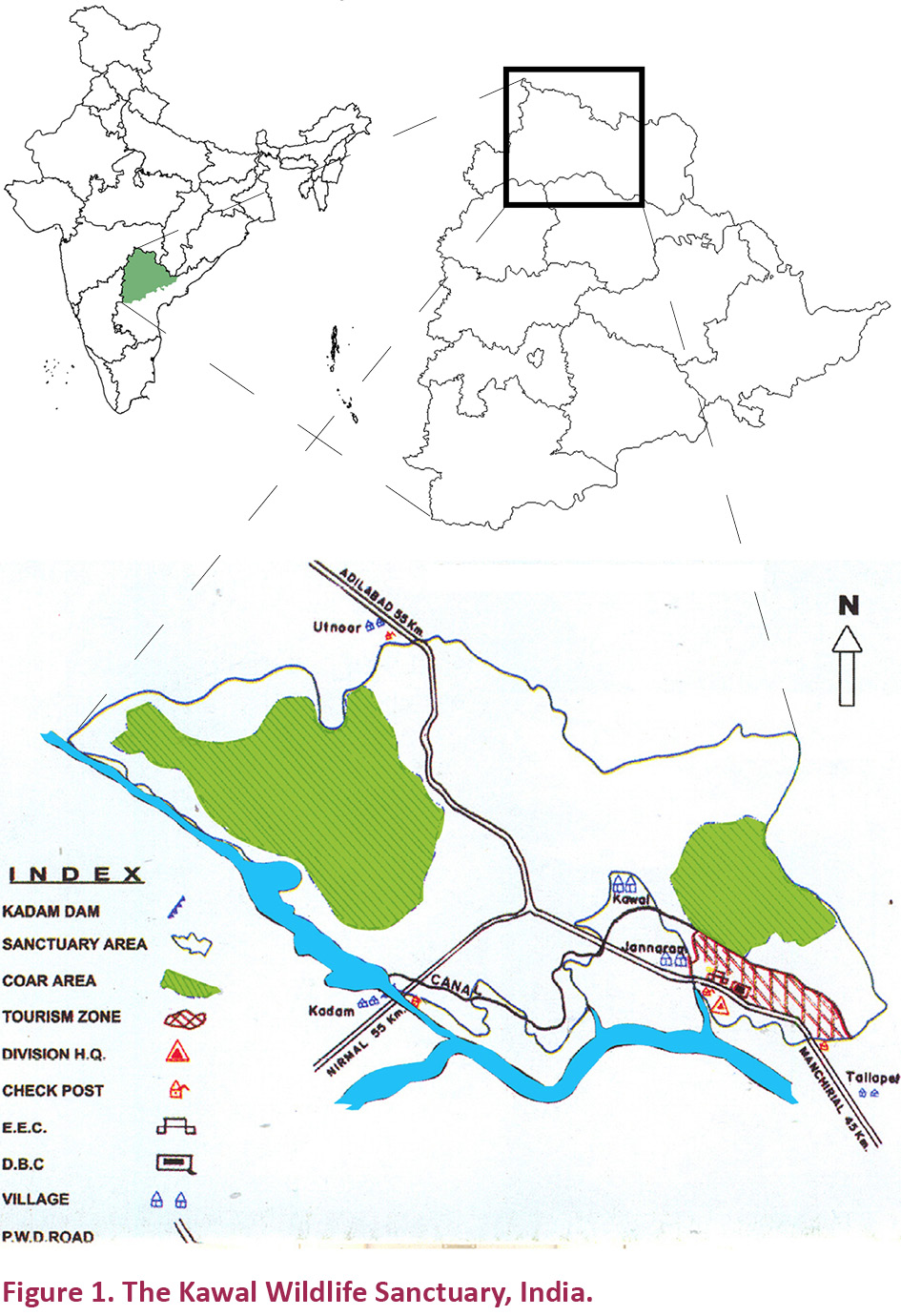
MATERIALS AND METHODS
A. Field sampling
The phytosociological study was carried out during January 2006 to January 2009 by laying random quadrats with the size of 20x20 m. The KWS was systematically surveyed for all trees ≥30cm girth at breast height (gbh - above 130cm from the ground). In addition, data on shrubs (5x5 m), herbs, climbers and saplings (1x1 m) were collected. Voucher specimens were prepared for identification and documentation and deposited at Kakatiya University Herbarium, (KUH), Warangal. The spatial location (latitude, longitude and altitude) of each quadrat was recorded using a GPS.
B. Data analysis
The vegetation data were quantitatively analysed for basal area, relative density, relative frequency and relative dominance (Phillips 1959). The importance value index (IVI) for the tree species was determined as the sum of the relative frequency, relative density and relative dominance (Cottam & Curtis 1956; Curtis 1959; Misra 1968). Some of the formulae are given below:
Species diversity of each forest type was determined as per Shannon & Weiner (1963).
H = - å [(ni/N) log 2 (ni/N)] where ni is the total number of individuals of species i and N is the total number of individuals of all species in that vegetation type.
The concentration of dominance was also measured after Simpson (1949).
C = - S (ni/N) where ni and N are the same as those for the Shannon-Weiner information function.
The Species Richness was computed using the well-known Margalef’s index (Margalef 1958). R = S-1/ln (n) S = number of species; n= number of individuals.
RESULTS
Forest Composition
For the phytosociology, 3.24ha of forests in the KWS were sampled by laying 81 sample points at random. On the whole, a total of 177 species of angiosperms were enumerated in the sample quadrats. The species present as per preponderance are trees (55), herbs (71), shrubs (18) and climbers (33). The predominant angiosperm families (Fig. 2) are Papilionaceae (23 species) followed by Rubiaceae (12 species), Acanthaceae (11 species) and Malvaceae (8 species). Martin & Aber (1997) reported Leguminosae (Fabaceae) as the most abundant family in neo-tropical forests. It is interesting to note that Papilionaceae alone (excluding Caesalpiniaceae and Mimosaceae) contribute to the stands (Fig. 2).
The species diversity indices indicate the following facts: Shannon-Weiner index was 4.15, indicating good species diversity, Simpson index (concentration of dominance) value was 0.91, Margalef’s species richness index was 5.20, density of trees above 10cm GBH class was 470 individuals per hectare. The total basal area of the tree species is 17.7m² haˉ1. These statistics along with the composition of the forest, information on the diversity of the communities put together provided a picture of the state of the forests in the KWS.
In the biological spectrum, phanerophytes are dominant (46.3%) followed by 21.5% chamaephytes, hemicryptophytes, therophytes and geophytes (Fig. 3). Although phaneorphytic climate is prevalent in the sanctuary, there is a tendency towards chamaephytic (dwarf shrubby) growth, due to the edaphic factor. The lesser number of therophytes are due to the good canopy shade on one hand and the poor soils on the floor. The geophytes are present as expected for the habitat.
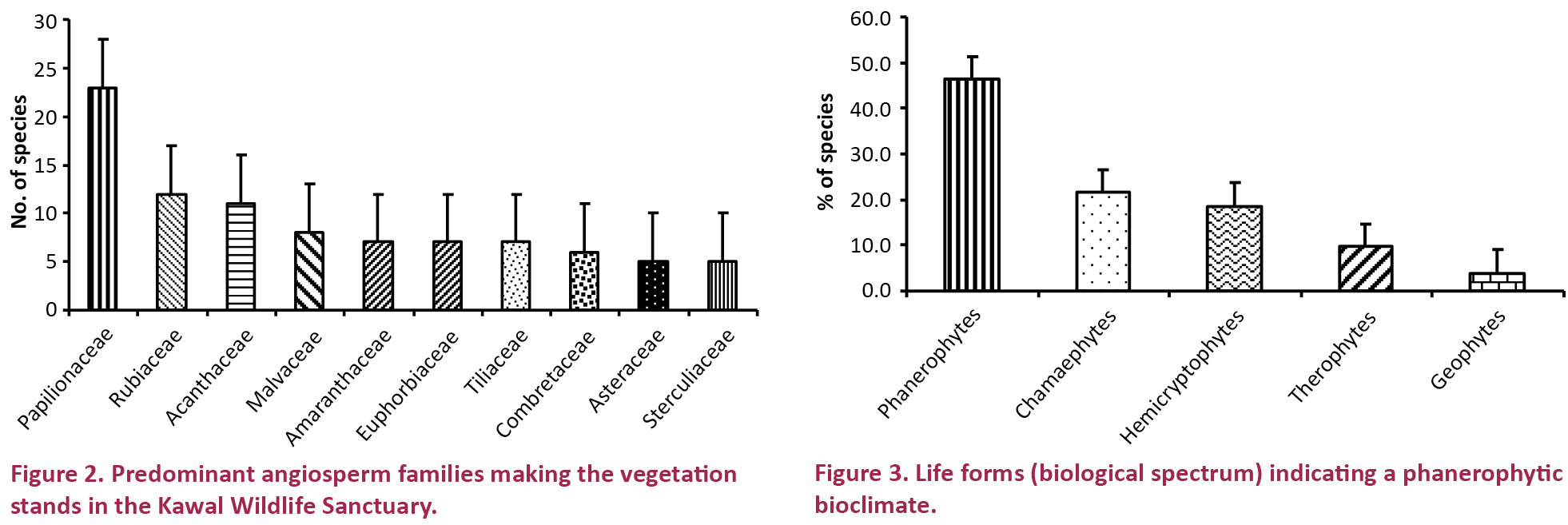
Forest structure
The proportional distribution of tree species across the girth class intervals reveal (Fig. 4) that 16–40 cm gbh class is dominant with 78.6% of individuals while 16.2% belong to 41–80 cm gbh class, 3.4% to 81–120 cm, and only 1.8% pertain to >120cm gbh class. Height-wise proportion of tree individuals (Table 1) indicates the prevalence of <5m height class in the sanctuary with 66.6% of individuals. There are 11% of individuals in 5–10 m and 11–15 cm, 10.2% in 16–20 m, and only 0.3% trees in >20m height class.
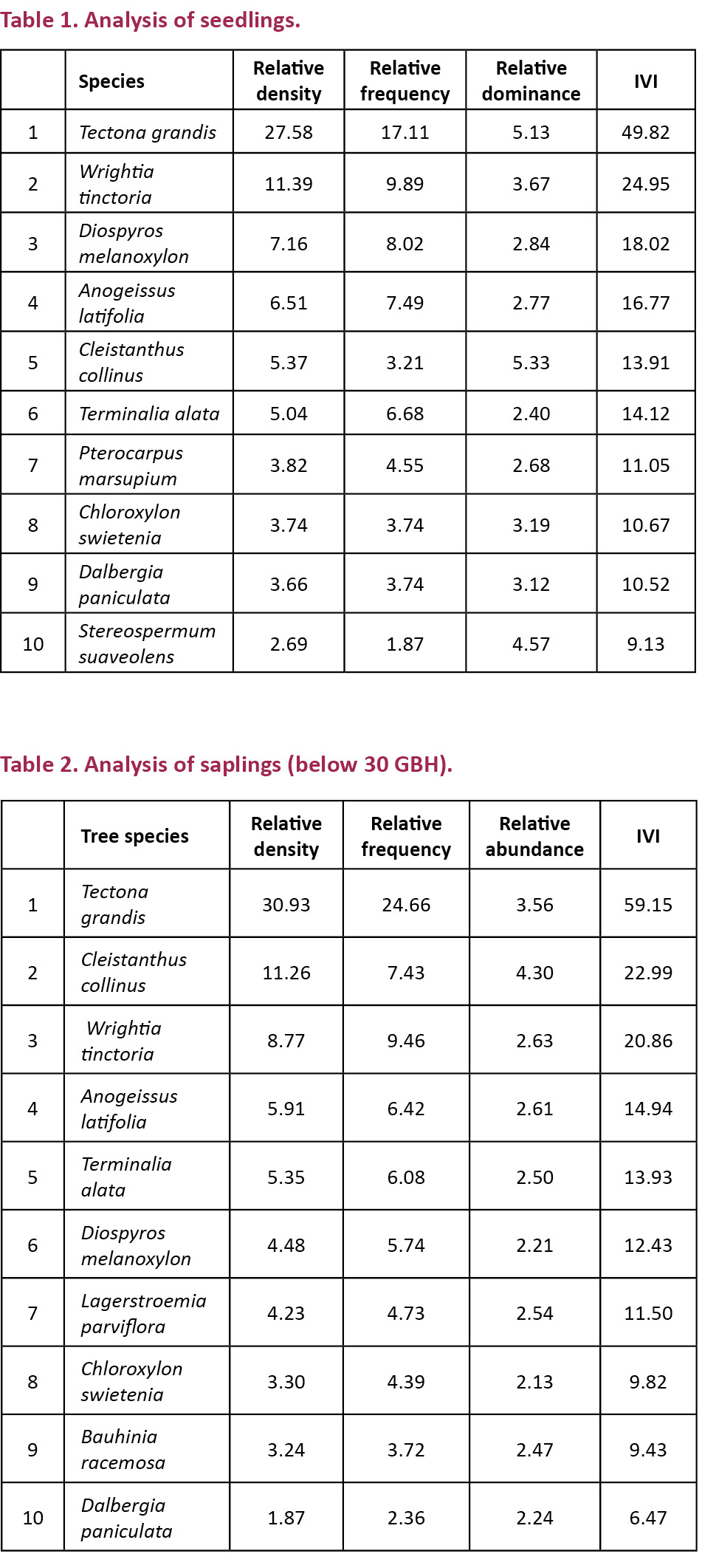
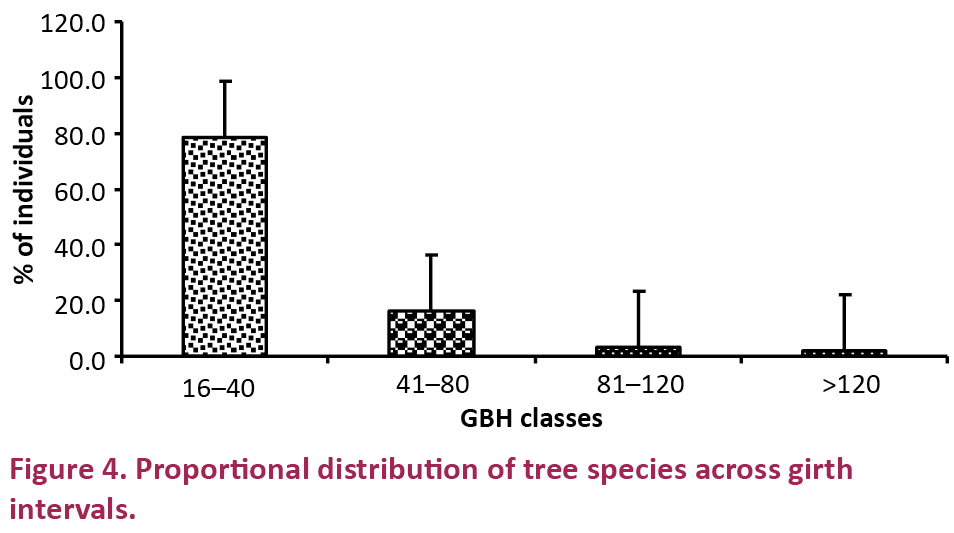
The population structure of the predominant species revealed that Tectona grandis is dominant with the highest number of adults, saplings and seedlings (Table 2; Fig. 5). It has a clear expanding population structure, occupying the majority of physical space with greater representation in community structure and making it a dry teak forest, also represented by Cleistanthus collinus, Anogeissus latifolia, Wrightia tinctoria, Terminalia alata, Lagerstroemia parviflora and Lannea coromandelica. However, Bauhinia racemosa, Pterocarpus marsupium and Acacia leucophloea had less than 5% of adults, saplings and seedlings.
DISCUSSION
The species-wise analysis shows that Tectona grandis is the dominant species in the sanctuary, with highest IVI value (95.24) (Table 3). This indicates the adaptability of Tectona grandis to the edaphic conditions prevailing throughout the sanctuary. Gopalkrishna (2000) discussed the relationship of the growth of teak with special references to geological conditions in Madhya Pradesh. He observed that the Gondwana system consists of freshwater sedimentary deposits which do not bear teak while the basaltic rocks are suited. The older rocks of Gondwana like the Talchirs, Barakars, etc. bear teak whereas the newer rocks are devoid of it. Teak is found in these Gondwana formations across the KWS. So, it falls under the Teak zone. The subdominant tree species are Anogeissus latifolia and Cleistanthus collinus with 20.27 and 19.49 IVI values. Economically (including medicinally) important species like Bridelia retusa, Cordia dichotoma, Schleichera oleosa, Diospyros montana and Strychnos potatorum showed the least IVI value (0.29) of the dominant tree species in the sanctuary. The phytosociology revealed that the forests in the sanctuary are of Tectona-Anogeissus-Cliestanthus type (Table 3).

These values indicate the structure of the forests in the study area. The information on the diversity of the communities and of the landscape as a whole provides a better insight into the status of the forests in the KWS. In the tropics, it is considered that spatial heterogeneity is high and therefore species accommodate themselves in myriad of niches available to them. All the trees measuring ≥ 30cm GBH were measured and the species names were recorded. For the shrubs, stems belonging to each species were counted (ranging from 1–10 cm GBH). Height of stems was measured and recorded. Names of the species were confirmed using local floras and field guides. Spatial heterogeneity is considered to be one of the factors that explain richness of species in tropical environment. The mean tree density is 851 trees/ha in the Kalakad-Mudanthurai Tiger Reserve (Parthasarathy 2001) while in Kawal it is 470 trees/ha and 273 trees/ha in Pranahita and 254 trees/ha in Siwaram Wildlife Sanctuary, Andhra Pradesh, India.
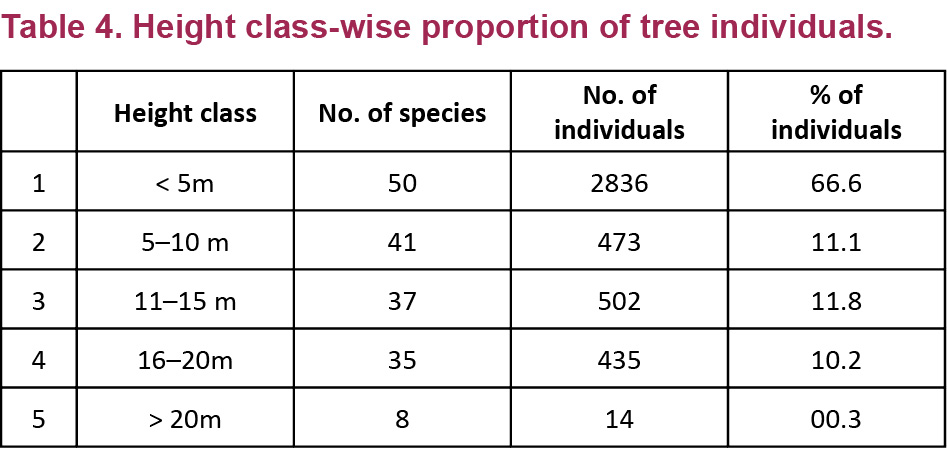
The sapling density of Tectona grandis is relatively very high (31), followed by Cleistanthus collinus, Wrightea tinctoria, Anogeissus latifolia. Regeneration of Tectona grandis is good (IVI 49.83) followed by Wrightea tinctoria (24.95), Diospyros melanoxylon (18) and Anogeissus latifolia (16.77). But, it was observed that in some parts of the wildlife sanctuary, natural regeneration of teak is very low due to factors like human-made fires, over-extraction and other biotic interference. It is also noted that Madhuca indica shows a very low regeneration capacity, again owing to biotic factors. The local ethnic people (Gonds, Nayakpods, etc.) collect its seeds for extraction of oil.
The hill slopes and the foothills of Tadlapet, Alinagar, Kistaipally, Islampur, Gandigopalpur, Rampur, Pembi Kadem and Danthanpally have teak forests mixed with Anogeissus latifolia and Terminalia alata. Bamboo is occasionally present on the hills and in valleys. Dendrocalamus strictus is present along the banks of major streams in Udumpur, Jannaram, Indanpally and Kawal ranges.
The unscientific and unregulated tapping of non timber forest products (NTFP) has lead to the loss of economically important tree species in the KWS. The local tribal people, who gather NTFPs cut large-sized trees to collect a small quantity of honey and to capture langurs and monitor lizards. Sterculia urens was found almost eliminated due to excessive and faulty (unscientific) gum tapping. Givotia rottleriformis, which is locally used for toy (Nirmal) making is cut as per the need. Besides, the total harvest of fruits of Phyllanthus emblica trees is leaving no food for wild animals, besides affecting the natural regeneration of the species. These three tree species, which are very important economic trees, typical of KWS are becoming rare and threatened; they need immediate conservation and multiplication.
The villages in Jannaram, Tadlapet and Indanpally forest ranges are relatively densely populated and have an impact on the forest. There are incidents like illicit removal of forest produce for fuel, hut and house building, agricultural implements, fencing material, green manure, fodder etc. which adversely affect the protected area. Fringe villages like Chinthaguda, Rotiguda, Revojipet, Kalamadugu, Kalleda, Murimadugu, Singaraipet, Tapalpur and Mohammadabad are involved in the illegal felling of teak. Timber is mainly transported illicitly through canals of Kadem and the River Godavari.
The basal area and vertical structure of a forest are difficult to summarise as these statistics rely heavily upon the local climate and the prevailing edaphic conditions. Tree height is heavily influenced by the density of saplings, richness of nutrients and biotic pressure. The proportional distribution of tree species across girth classes (Fig. 4) disclosed that 16–40 cm gbh class is dominant in the study area. It shows the further availability of timber-yielding species, which is a fact that could be explained by virtue of the harvest being in a protected area. The height-wise proportion of tree individuals of the sanctuary (Table 4) indicates the prevalence of 5–10 m height class. There are 66.7% of tree individuals in <5m, 11.1% in 5–10 m, 10.2% in 16–20, and only 0.3% in >20m height class.
Regeneration
The regeneration of Tectona grandis is fairly good (IVI 49.83), followed by Wrightea tinctoria (24.95), Diospyros melanoxylon (18) and Anogeissus latifolia (16.77). Almost 50% of the seedling recruitment in the local forest is by Tectona (Table 1). However, the saplings found bring forth Wrightea tinctoria over Anogeissus latifolia. The former was in fifth place in regard to IVI of adults. In seedling recruitment, Wrightia tinctoria even surpassed Cleistanthus. Wrightea recruits almost half of the remaining tree seedlings in the forest type. May be the recurring and abundant fire played a positive role for Wrightia tinctoria with its better regeneration ability after fire. The seeds of Wrightia are wind blown and better dispersed. The competition among the seedlings is promoted by deforestation, soil erosion, fire and loss of natural (original) ground cover. It is also observed that Madhuca indica showed a very low regeneration ability owing to edaphic and biotic factors. The local tribal people (Gonds, Nayakpods, etc.) collect its flowers (fleshy corolla) and the seeds of the Madhuca indica for preparation of an indigenous popular beverage called ‘Ippa sara’ and for the extraction of oil, respectively. The overall expanding tree population structure of the KWS represents a typical mature stand with good regeneration ability. The lesser slopes and plains have teak and allied species while the higher altitudes have species like Boswellia serrata, Givotia rottleriformis, etc. The change in topography has also affected the moisture regime of the region. The development of the vegetation depends upon the parent material of the rocks and in the attendant soils.
Changing vegetation - prediction
The prediction of future vegetation cover of the KWS is that, being distant to populace and ideal for Tiger habitat it will remain largely unchanged for sometime. However, the threat to teak is imminent from smugglers and over-exploiting native people, facilitated by the laying of roads through the sanctuary. Unchecked by biotic pressure, it may be replaced by Cleistanthus collinus, a species of far less economic value.
Species diversity (richness) is an expression of community structure and heterogeneity. Richness tends to increase over the area. A larger habitat harbours more different species, probably because of the possible presence of a variety of micro habitats and resources. Plant communities give a better indication of the nature of the environment than we can obtain by measuring the individual factors. The character and make-up of vegetation is an expression of synergic effect of all factors operating in a habitat (Oosting 1956). Raunkiaer’s life forms (Raunkiaer 1934) of the study area were analysed to infer the phytoclimate. The biological spectrum of any natural ecosystem can be compared/studied with Raunkiaer’s data. The phanerophytes are dominant (46.3%) followed by 21.5% chamaephytes. Although phaneorphytic climate is prevalent in the sanctuary, there is a tendency towards chamaephytic (dwarf shrubby) growth. The lesser number of therophytes indicates the good canopy and less disturbance on the ground in the study area.
The population structure of the predominant species revealed that Tectona grandis is dominant with highest number of adults, saplings and seedlings (Table 5; Fig. 5). It has a clear expanding population structure, occupying majority of physical space with greater representation in community structure and making it a dry teak forest, subordinated by Cleistanthus collinus, Anogeissus latifolia, Wrightia tinctoria, Terminalia alata, Lagerstroemia parviflora and Lannea coromandelica. Economic species like, Bauhinia racemosa, Pterocarpus marsupium and Acacia leucophloea present with less than 5% of adults, saplings and seedlings.
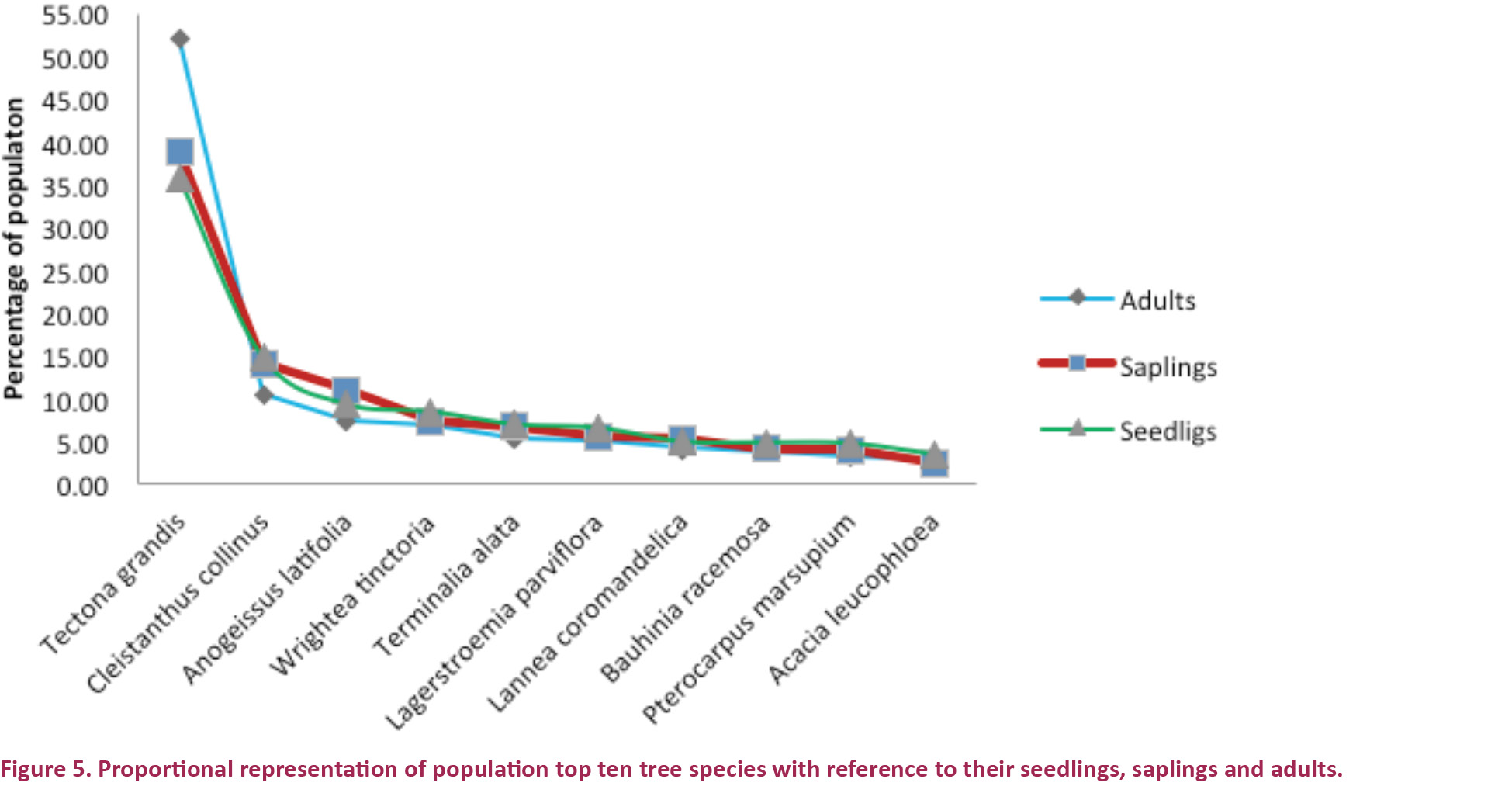
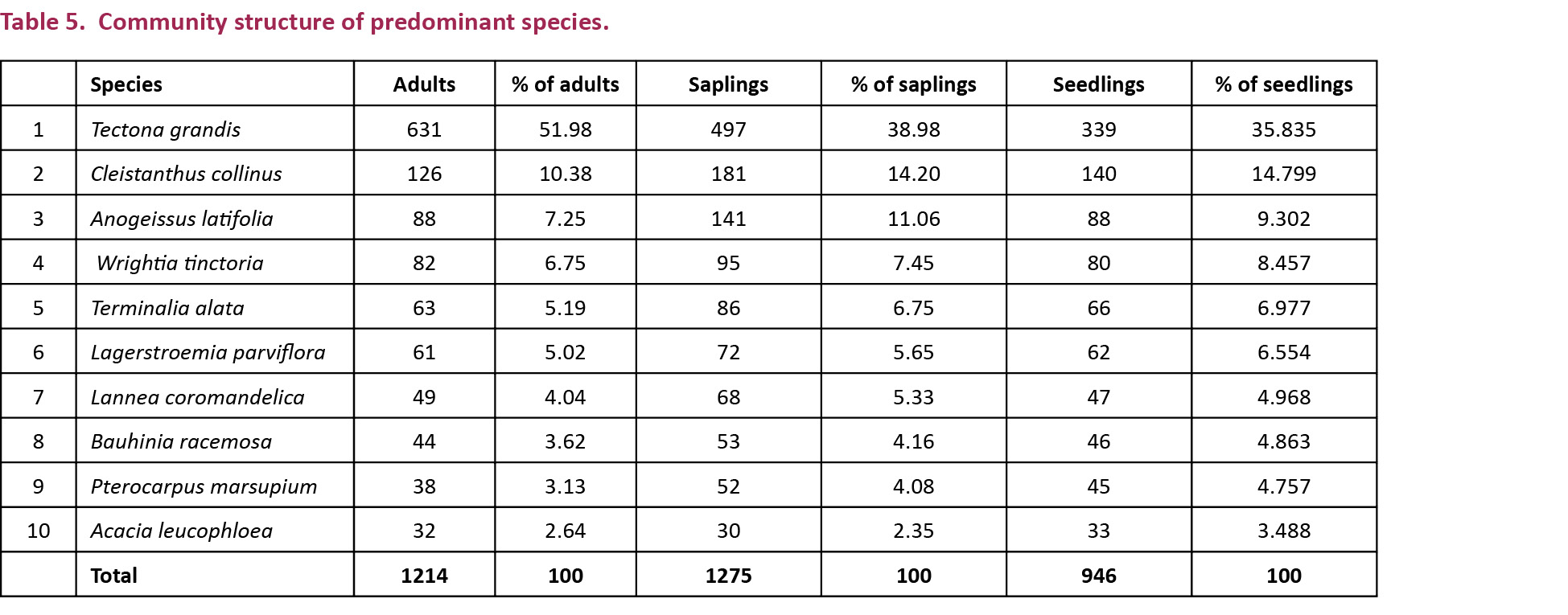
Tropical deforestation has been about twice as high in Asia than in either Latin America or Africa. Tropical Asia has less remaining forests, higher rates of deforestation and logging and much higher population densities than other major tropical regions. Both expanding human populations and industrial development, logging and exotic tree plantations are important drivers of forest loss. The forests of tropical Asia are also among the most threatened on earth (Laurance 2007). Invasive exotic plants are a growing threat to the maintenance of native species and to the ecosystem integrity of wild habitats. The uncontrolled expansion of invasive exotic species can jeopardize the protection status of natural reserves and preclude the protection designation of otherwise high priority conservation areas (Denslow 2007). The prevention and early eradication are often seen as cost effective means of managing invasive species. According to the CBD, the second worst threat to the existence of biodiversity is the biological invasion of exotic species (WCMC 1992). So, urgent steps should be taken to control the predominance of Ageratum conyzoides, Chromolaena odorata, Hyptis suaveolens and Lantana camara (Reddy et al. 2008; Reddy 2009; Murthy et al. 2009, 2010). Furthermore, KWS was not spared from heavy anthropogenic pressure in the form of clearing of forest land to get acquisition rights under the recently passed Forest Rights Act (FRA) which added fuel to the fire by encouraging even non-tribes to encroach and demarcate protected areas that are crucial to the wildlife habitats.
CONCLUSIONS
In recent years, the vegetation of the Kawal Wildlife Sanctuary has been subjected to increased anthropogenic pressure, poachers for wildlife and teak for their livelihood (Murthy 2010). These activities ultimately lead to habitat destruction of herbivores which adversely affect the availability of Tigers’ prey, while the predators are under increased threat from intensification of agriculture, grazing of livestock in the environs of the protected area.
As part of the conservation approach, ecotourism and the harvesting of non-timber forest produce have often been presented as two viable alternatives for local communities to generate income. There is a great impact on species loss and changing ecosystem structure and function. It is highly desirable to establish a long term monitoring plan to study the dynamics of the forest. Forest fires favour abundant grass growth while destroying the delicate tree/shrub/climber species. Cymbopogon acts as an accelerator and adds fuel to the fire, because of the presence of Citronella oil in its leaves (Krishnaiah et al. 2002). Due to the above mentioned reasons, the forest cover is shrinking at an alarming rate. Besides, the disappearance of woodlands is causing extensive destruction of wildlife. A holistic approach is the need of the hour to conserve KWS.
REFERENCES
Bahuguna, V.K. (1999). Forest fire prevention and control strategies in India. International Forest Fire News 20: 5–9.
Champion, H.G. & S.K. Seth (1968). A Revised Survey of the Forest Types of India. Government of India Publications, New Delhi.
Cottam, G. & J.T. Curtis (1956).The use of distance measurement in phytosociological sampling. Ecology 37: 451–460.
Curtis, J.T. (1959). The Vegetation of Wisconsin. An Ordination of Plant Communities. University Wisconsin Press, Madison, USA.
Denslow, S.J. (2007). Managing dominance of invasive plants in wild lands. Current Science 93: 1579–1586.
Gentry, A.H. (1989). In Tropical Forests, Botanical Dynamics, Speciation and Diversity. Academic Press, London.
Gentry, A.H. (1990). Floristic similarities and differences between southern central America and upper and central Amazonia, pp. 141–157. In: Gentry, A.H. (ed.). Four Neotropical Rainforests. Yale University Press, Connecticut.
Gopalkrishna, P. (2000). Application of Geoinformatics in Vegetation-Ecosystem Analysis in part of Godavari Valley, Warangal, Andhra Pradesh. PhD Thesis, Kakatiya University, Warangal.
Janzen, D.H. (1988). Tropical dry forests: The most endangered major tropical ecosystem, pp. 13–137. In: Wilson, E.O. (ed.). Biodiversity. National Academy Press. Washington DC.
Krishnaiah, P., V. Venkatramaiah & G. Sudarshanam (2002). Effect of fire controls measures on improvement of vegetation of Tirumala Hills and surroundings. Proceedings of the National Seminar on Conservation of Eastern Ghats. 24–26 March, EPTRI, Hyderabad.
Laurance, W.F. (2007). Forest destruction in Tropical Asia. Current. Science 93: 1544–1550.
Margalef, R. (1958). Information theory in ecology. General Systematics 3: 36–71.
Martin, M.E. & J.D. Aber (1997). High spectral resolution remote sensing of forest canopy lignin, nitrogen and ecosystem processes. Ecological Applications 7: 431–443.
Misra, R. (1968). Ecology Workbook. Oxford and IBH. Publishing Co, New Delhi.
Murphy, P.G. & A.E. Lugo (1986). Ecology of tropical dry forests. Annual Review of Ecology and Systematics 17:67-88.
Murthy, E.N., A. Ragan, G. Ravinder & V.S. Raju (2008). Kawal Sanctuary needs the status of Tiger Reserve. Current Science 94: 430.
Murthy, E.N., C.S. Reddy & V.S. Raju (2009). Assessment of impact of Hyptis suaveolens in the Protected Areas of Southern India. Book of Abstracts. World Conference on Biological Invasions and Ecosystem Functioning. Porto, Portugal, 27–30 October, 2009, 134pp.
Murthy, E.N., C.S. Reddy, M. Ravinder & V.S. Raju (2010). Exotic weeds in Tadoba-Andhari Tiger Reserve. Current Science 99: 863–864.
Murthy, E.N. (2010). Phytosociology, Phytodiversity and Biological Integrity of Kawal, Pranahita and Siwaram Wildlife Sanctuaries in Adilabad District of Andhra Pradesh, India. PhD Thesis, Kakatiya University, Warangal.
Oosting, (1956). The Study of Plant Communities. W.H. Freman & Co, California.
Parthasarathy, P. (2001). Changes in forest composition and structure in three sites of tropical evergreen forest around Sengaltheri, Western Ghats. Current Science 80: 389–393.
Pascal, J.P. & R. Pelissier (1996). Structure and floristic composition of a tropical evergreen forest in southwest India. Journal of Tropical Ecology 12: 191–214.
Phillips, E.A. (1959). Methods of Vegetation Study. Henri Holt Co Inc, New York.
Raunkiaer, C. (1934). The Life Forms of Plants and Statistical Geography. Clarendron Press, Oxford.
Reddy C.S., B. Shilpa, A. Giriraj, K.N. Reddy & K.T. Rao (2008). Structure and floristic composing of tree diversity in tropical dry deciduous forests of Eastern Ghats, Southern Andhra Pradesh, India. Asian Journal of Science and Research 1: 57–64.
Reddy, C.S., G. Bhagyanarayana, K.N. Reddy & V.S. Raju (2008).Invasive Alien Flora of India. National Biological Information Infrastructure, USGS, USA.
Reddy, C.S. (2009). Biological invasions - a global terror. Current Science 90: 1235.
Shannon, C.E. & W. Weiner (1963). The Mathematical Theory of Communication. University of Illinois Press, Urbana, USA
Simpson, E. H. (1949). Measurement of diversity. Nature 163: 688.
World Conservation Monitoring Centre (WCC) (1992). Global Biodiversity: Status of the Earths Living Resources. Chapman and Hall, London.